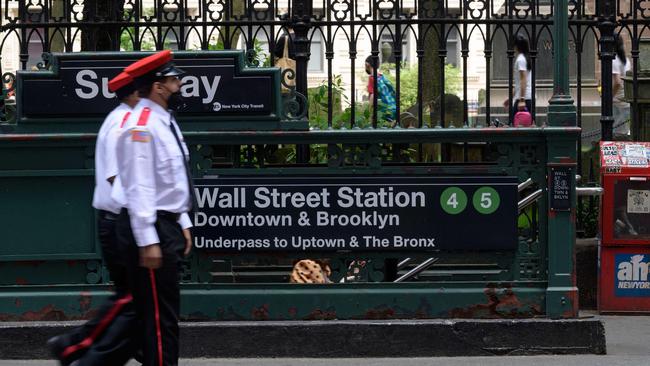Wall Street bounces off lows, but jury is out on economy
Anything short of a recession will catch the majority of investors “completely wrong-footed”, says JPMorgan.

The jury is out on the US economy but anything short of a recession will catch the majority of investors “completely wrong-footed”, according to JP Morgan.
Broad and severe drawdowns in the US sharemarket are 75 per cent of the way to prior recession bottoms, the investment bank says. If so, the risk versus reward has shifted to buying dips.
After its fourth worst start to the year in 100 years the US benchmark share index rose 6.6 per cent last week. That was the best week on Wall Street since the US election in November 2020.
Ahead of the restart of US trading after Memorial Day, S&P 500 futures jumped 0.9 per cent in Monday’s local session, adding to Friday’s bullish leads from Wall Street which saw Australia’s ASX 200 index rise 1.5 per cent to 7286 points – its best day in two weeks.
As of the middle of last week the S&P 500 was down more than 17 per cent for the year to date.
Such a bad start to the year has only been exceeded in the Great Depression, World War II and the Vietnam War, according to a study by JP Morgan. The US sell-off intensified with a seven-week fall which marked the longest losing streak on Wall Street in more than two decades.
The losing streak in US shares ended after minutes of the Fed’s May board meeting backed recent “Fedspeak” which opened up the possibility of a pause on rate increases after rapid-fire hikes.
“Many participants judged that expediting the removal of policy accommodation would leave the committee well positioned later this year to assess the effects of policy firming and the extent to which economic developments warranted policy adjustments,” the Fed minutes said.
Encouragingly, April’s US core PCE deflator met expectations of a 0.3 per cent rise, with falls in used car and apparel prices, putting the annualised rate for the three months to April at 4.3 per cent.
That’s the lowest in six months after a peak of 6.3 per cent and high outcomes a year ago should help contain year-on-year comparisons for May and June, according to NAB.
US personal spending rose 0.9 per cent versus the 0.8 per cent expected for April as consumers continued to use savings to keep spending.
And while the household savings rate of 4.4 per cent was the lowest since 2008, the stock of “excess” savings accumulated during the pandemic – thanks to fiscal transfers combined with an inability to spend on services – was “still huge” at $US2.2 trillion ($3 trillion).
“This is more than 10 per cent of GDP and suggests that if there is to be a significant slowdown in the US economy or outright recession it is unlikely to be this year,” said NAB’s Ray Attrill.
A bad start to the year for US shares – amid the start of Fed rate hikes and quantitative tightening – came in a backdrop of record share buybacks and sharply higher insider buying activity.
With strong buyback execution activity of more than $US285bn through the March quarter and “elevated activity” some 3-4 times more than the trend in recent weeks, buyback activity was poised to reach an unprecedented $US600bn in the first half of 2022, said JP Morgan’s head of equity macro research, Dubravko Lakos-Bujas.
“Absent this corporate liquidity, S&P 500 drawdown would likely have been much higher than 20 per cent and suggests investor positioning unwind was much greater,” he said.
That may explain why the median stock drawdowns in small caps and unprofitable companies – which are typically less active with buybacks – have been far worse and in line with prior major sell-offs.
In Lakos-Bujas’s view, sharemarket capitalisation-weighted indices “hide the carnage”.
In terms of average stocks, the fall in the Nasdaq was 51 per cent. Similarly, the average stock in the broader Russell 2000 index was down 47 per cent.
“Small caps traded at 12.5 times price-to-earnings during this sell-off – the same trough multiple as the March 2009 GFC bottom, the growth factor reached parity to the market, defensive stocks traded at an almost record premium over cyclicals, and some micro themes were down 40-70 per cent after large outflows and sharply higher short interest,” Lakos-Bujas added.
Encouragingly, corporate insiders are holding a non-consensus view across most sectors and buying the dip with net insider buying activity reaching one standard deviation above trend.
Market internals now point to an “extremely bearish set-up” – a contrarian buy signal – as investor sentiment is already very negative and portfolios are defensively positioned for “end of cycle and a recessionary outcome”.
“Anything short of a recession will likely catch most investors completely wrong-footed, in our view, especially after broad and severe drawdowns that are 75 per cent of the way to prior recession bottoms,” Lakos-Bujas said.
“At the current juncture defensive stocks possess valuation risk while flushed out cyclicals, growth and small caps are presenting an increasingly attractive risk versus reward.
“Investors are likely to rotate out of defensive stocks if this sell-off proves to be another mid-cycle scare,” he added. “Alternatively, if the economy actually falls into a recession, defensive stocks are likely to rollover as investors use it for source of funding.”
Energy is seen as the best risk-reward sector under both outcomes.




To join the conversation, please log in. Don't have an account? Register
Join the conversation, you are commenting as Logout